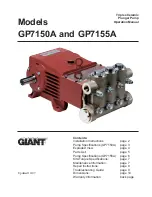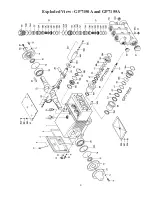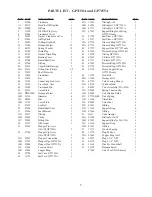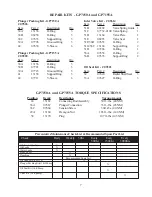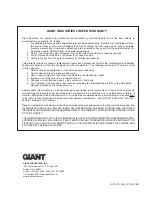
8
TO CHECK VALVES
Loosen plugs (58), take out tension spring (57) and then remove the complete valve assembly (51) with
either a valve tool or an M16 hexagon screw. To remove the valve adapter (56) and tension spring (57),
use a pullout tool size 5. The o-ring (51H) can be removed with a bent piece of wire. To disassemble valve
assembly, screw out the valve seat (51E) from the spring tension guide (51A). Check the sealing surfaces
and replace worn parts. Check O-rings and support rings. Tighten plugs (58) to 107 ft.-lbs. (145 NM).
TO CHECK SEALS AND PLUNGER PIPE
Loosen nuts (49A) and remove pump head (50). Separate the plunger connection (36A) from the cross-
head (25) by means of two open-end wrenches (size 22mm and 27mm). Pull seal sleeves (39) out of their
fittings in the crankcase (1). Take the seal case (38) out of the seal sleeve (39). Examine the plunger parts
(36A-36D), seals (42 & 39A) and O-rings. When replacing the plunger pipe (36B), tighten tension screws
(36C) to 30 ft. lbs. (40 NM). Replace worn parts; grease seals with Silicone before installing.
CAUTION:
Don't loosen the 3 plunger connections (36A) before the valve casing has been removed
otherwise the tension screw (36C) could hit against the valve adapter (56) when the pump is
being turned. Seal life can be increased if the pre-tensioning allows for a little leakage. This
assists lubrication and keeps the seals cool. It is therefore not necessary to replace seals
before the leakage becomes too heavy and causes output and operating pressure to drop.
MOUNTING VALVE CASING
Check O-rings on the seal case (38). Clean surfaces of seal sleeves in gear box and sealing surfaces of
valve casing (50). Push the valve casing carefully on the O-rings of the seal case and centering studs (50A).
Tighten nuts (49A) to 103 ft. lbs. (140 NM).
TO DISASSEMBLE GEAR
Take out plunger (36) and seal sleeves (39) as described above. Drain the oil. After removing the circlip
ring (33B), lever out seal retainer (33) with a screw driver. Check seals (32 & 33A) and surfaces of
crosshead (25) . Remove the crankcase cover (4). Loosen inner hexagon screws on the connecting rods
(24).
Note:
Connecting rods are marked for identification. Do not twist connecting rod halves. Each connect-
ing rod is to be reinstalled in the same position (and orientation) on the crankshaft journals.
Push the connecting rod halves as far into the crosshead guide as possible. Check the surfaces of connect-
ing rod and crankshaft (22). Take out the bearing cover (14) to one side and push out crankshaft taking
particular care that the connecting rod doesn’t bend.
Re-assemble in reverse order. Regulate axial bearing clearance to a minimum of 0.1mm and a maximum of
0.15mm by means of fitting discs (20A). The crankshaft should turn easily and with little clearance. Tighten
screws (24) to 30 ft.-lbs. (40 NM).
Important!
The connecting rod has to be able to slightly move sidewise at the crankshaft journal.
Important!
Seal (32) must always be installed so that the seal-lip on the inside diameter faces the oil.
Possible axial float of the seal retainer (33) should be compensated with the shims (33C).
GP7150A and GP7155A Repair Instructions
Summary of Contents for GP7150A
Page 4: ...4 Exploded View GP7150A and GP7155A...
Page 10: ...GP7150A and GP7155A Dimensions Inches mm 10...
Page 11: ...11...

